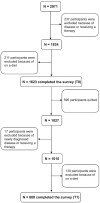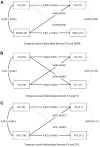Prediction of body fat increase from food addiction scale in school-aged children and adolescents: A longitudinal cross-lagged study
- PMID: 36684883
- PMCID: PMC9853519
- DOI: 10.3389/fpubh.2022.1056123
Prediction of body fat increase from food addiction scale in school-aged children and adolescents: A longitudinal cross-lagged study
Abstract
Objective: Food addiction (FA) is associated with a higher body mass index z-score (BMIZ) in children and adolescents; however, whether these two aspects evolve interdependently remains unknown. This study aimed to address this question using a cross-lagged study.
Methods: Weight status, including BMIZ, fat content (FC), and visceral fat level (VFL), was determined in 880 children and adolescents (mean age = 14.02 years [range = 8.83-17.52 years]) at two-time points with an interval of 6 months. FA was characterized using the Chinese version of the dimensional Yale Food Addiction Scale for Children 2.0. Furthermore, FC and VFL were measured using direct segmental multi-frequency bioelectrical impedance analysis at each time point.
Results: Higher FA was associated with increased BMIZ, FC, and VFL (P < 0.05). FA at T0 could predict increased FC at T1 (P < 0.05). The characteristics of females, primary students, and living in urban areas may aggravate the adverse effect of FA on weight status over time and age, particularly the increased VFL in participants aged > 14 years.
Conclusion: Children and adolescents with a high FA level were at risk for weight gain attributed to increased FC, and the adverse effect could be aggravated with time and age. Novel FA-targeting interventions may help mitigate the risk of getting obesity.
Keywords: adolescents; body composition; children; cross-lagged analysis; food addiction; longitudinal study; obesity.
Copyright © 2023 Wang, Zhou, Hu, Che, Ye, Chen, Fu and Xu.
Conflict of interest statement
The authors declare that the research was conducted in the absence of any commercial or financial relationships that could be construed as a potential conflict of interest.
Figures



Similar articles
-
Food addiction and its impact on weight status in children and adolescents: The mediating role of responsive eating pattern.Pediatr Obes. 2024 Feb;19(2):e13090. doi: 10.1111/ijpo.13090. Epub 2023 Dec 26. Pediatr Obes. 2024. PMID: 38148618
-
The Association Between Food Addiction and Weight Status in School-Age Children and Adolescents.Front Psychiatry. 2022 May 9;13:824234. doi: 10.3389/fpsyt.2022.824234. eCollection 2022. Front Psychiatry. 2022. PMID: 35615452 Free PMC article.
-
Emotional and behavioral problems associated with food addiction in children and adolescents with obesity.Obes Res Clin Pract. 2025 Jan-Feb;19(1):34-42. doi: 10.1016/j.orcp.2025.02.002. Epub 2025 Feb 15. Obes Res Clin Pract. 2025. PMID: 39956734
-
[Simple obesity in children. A study on the role of nutritional factors].Med Wieku Rozwoj. 2006 Jan-Mar;10(1):3-191. Med Wieku Rozwoj. 2006. PMID: 16733288 Review. Polish.
-
Meeting of Minds around Food Addiction: Insights from Addiction Medicine, Nutrition, Psychology, and Neurosciences.Nutrients. 2020 Nov 20;12(11):3564. doi: 10.3390/nu12113564. Nutrients. 2020. PMID: 33233694 Free PMC article. Review.
References
-
- Abarca-Gómez L, Abdeen ZA, Hamid ZA, Abu-Rmeileh NM, Acosta-Cazares B, Acuin C, et al. . Worldwide trends in body-mass index, underweight, overweight, and obesity from 1975 to 2016: a pooled analysis of 2416 population-based measurement studies in 128·9 million children, adolescents, and adults. Lancet. (2017) 390:2627–42. 10.1016/S0140-6736(17)32129-3 - DOI - PMC - PubMed
MeSH terms
LinkOut - more resources
Full Text Sources

